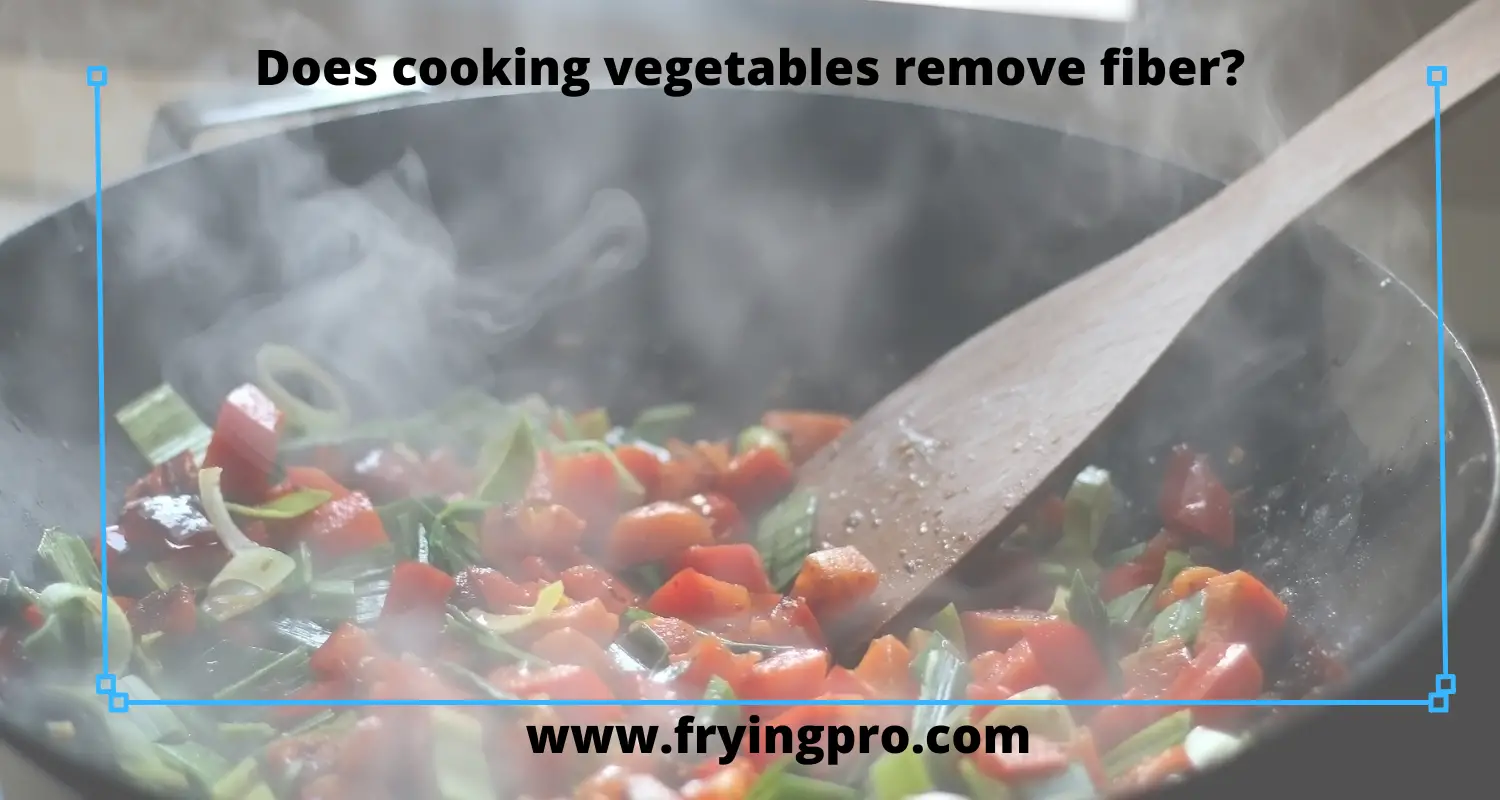We all know that vegetables are good for us. They’re packed with nutrients like vitamins, minerals, and antioxidants. But a critical nutrient in vegetables is fiber. Fiber is vital for digestion and helps keep us feeling full after eating.
But does cooking vegetables remove the fiber? This blog post will help you find the exact answer backed by scientific evidence.
Does cooking vegetables remove fiber?
Cooking vegetables changes the amount of fiber, such as Lignin and Cellulose, in vegetables such as Cabbage, Carrots, Broccoli, and Okra. However, the change in fibre value of these vegetables due to cooking is not physiologically significant since the amounts of fibre present in and consumed from these vegetables are very small.
| Moisture (%) | Lignin (% dry weight) | Cellulose (% dry weight) | |
| Carrot | 92.5 | 1.32 | 9.7 |
| Cabbage | 93.9 | 1.26 | 11.04 |
| Broccoli | 93.6 | 1.73 | 14.23 |
| Okra | 93.4 | 1.46 | 8.86 |
What is fibre?
Fiber, also known as dietary fiber or roughage, is the indigestible part of plant foods. It’s composed chiefly of carbohydrates like cellulose, lignin, and pectin.
While we don’t digest fiber, it’s vital for our health. Fiber helps us feel full and satisfied after eating. It also aids digestion by keeping things moving through our gut and preventing constipation.
Most people should aim for 25 grams of fiber per day. Good sources of fiber include fruits, vegetables, whole grains, legumes, and nuts.
How much fibre is present in vegetables?
Vegetables are an excellent source of dietary fibre. The average person needs around 25-30 grams of fibre per day, and most vegetables contain at least 2 grams of fibre per serving.
For example, a medium-sized potato contains 3 grams of fibre, a cup of cooked broccoli contains 5 grams of fibre, and a cup of cooked spinach contains 7 grams of fibre.
Dietary fibre is vital for maintaining a healthy digestive system and preventing constipation. Fibre also helps to regulate blood sugar levels and can reduce the risk of heart disease and other chronic conditions such as obesity and type II diabetes.
So how much fibre should you be eating each day? The answer depends on your age, gender, and activity level. The recommended daily amount of fibre for adults is 25 grams each day. This target can be met with high-fiber foods such as fruits, vegetables, whole grains, and legumes (beans, lentils).
How does heat affect nutrients like carbohydrates, protein, and fibre?
When we cook food, the heat breaks down the nutrients and makes them more easily digestible for our bodies. But not all nutrients are affected in the same way by heat. Here’s a look at how heat affects three major nutrients: carbohydrates, protein, and fibre.
Carbohydrates are one of the most heat-sensitive nutrients. When exposed to high temperatures, they can break down into simple sugars. This process is called caramelization, which gives roasted foods their characteristic sweetness.
While this might sound good, too much sugar can harm our health. It can cause spikes in blood sugar levels, leading to diabetes and other health problems.
Protein is also affected by heat, but differently. When heated, protein molecules unravel and change shape.
What vegetable has the most fiber?
We all know that vegetables are good for us. But which vegetable has the most fiber? The answer may surprise you.
The highest-fiber vegetable is the humble artichoke. One giant artichoke contains a whopping 10 grams of fiber. That’s about a third of the recommended daily intake for adults!
Among other vegetables with the most fibre are beetroot and celeriac, with 8 grams of fiber per serving. Artichokes also contain a lot of iron, calcium, magnesium, and potassium. As well as vitamins A, C, and B6.
What is the healthiest way to cook vegetables?
Cooking vegetables has been shown to decrease their nutrient content. The healthiest way to cook vegetables is by steaming them. This cooking method preserves the most nutrients, particularly water-soluble vitamins and minerals.
Vegetables are an essential part of a healthy diet. They are low in calories and fat and high in fiber and vitamins. However, their nutrient content can be decreased by cooking. The healthiest way to cook vegetables is by steaming them. This cooking method preserves the most nutrients, particularly water-soluble vitamins and minerals.
Steaming involves cooking food in hot vaporized water. The heat from the steam cooks the food without exposing it to direct heat, as in boiling or frying. This results in less nutrient loss than other methods of cooking.
Steamed vegetables retain more vitamins, minerals, color, and flavor than boiled or fried vegetables.
In addition to steaming, another healthy way to cook vegetables is to sauté them in a small amount of vegetable oil. Vegetable oils, including olive, canola, and corn, contain heart-healthy unsaturated fats that help reduce blood cholesterol levels.
How to retain maximum fibre in vegetables?
The loss of water and nutrients during storage is one of the main reasons vegetables lose their fibre content. There are a few simple ways to help retain maximum fibre in vegetables:
i. Store vegetables in a cool, dark place. Exposure to light and heat can cause vegetables to lose water and nutrients.
ii. Wash vegetables thoroughly, but avoid soaking them for too long as this can also lead to nutrient loss.
iii. Cook vegetables quickly using methods such as steaming or stir-frying. Slow cooking methods can cause veggies to lose nutrients, including fibre.
Is it better to eat vegetables raw or cooked?
There are benefits to both raw and cooked vegetables. It depends on the vegetable and the nutrient. For example, lycopene, an antioxidant found in tomatoes, is more available from cooked tomatoes than raw tomatoes. Lycopene is fat-soluble, so it’s better absorbed with a little fat, such as olive oil added to a salad or when tomatoes are used in cooking.
Cooking can also make some nutrients more available. For example, beta-carotene in carrots and lutein in spinach are more available from cooked vegetables than from raw ones. On the other hand, vitamins C and B6 are lost during cooking. So if you want these particular nutrients, eat these vegetables raw.
Which food items lose the most amounts of fiber when cooked?
When it comes to cooking, not all methods are created equal—especially when preserving nutrients. Generally, the less processed food, the more nutrient-rich it will be. This is especially true for foods high in fiber, which tend to lose a significant amount of their nutrient content when cooked.
So, which food items lose the most fiber when cooked? Here are a few examples:
1. Broccoli: When cooked, broccoli loses about 60% of its total dietary fiber content. Steaming or cooking broccoli for just two minutes can help preserve its nutrient levels.
2. Spinach: Like broccoli, spinach also loses a significant amount of its dietary fiber content when cooked.
Conclusion
Cooking vegetables does not significantly impact the fiber content of vegetables. However, there are better and healthier ways to cook vegetables, such as stir-frying and steaming.






